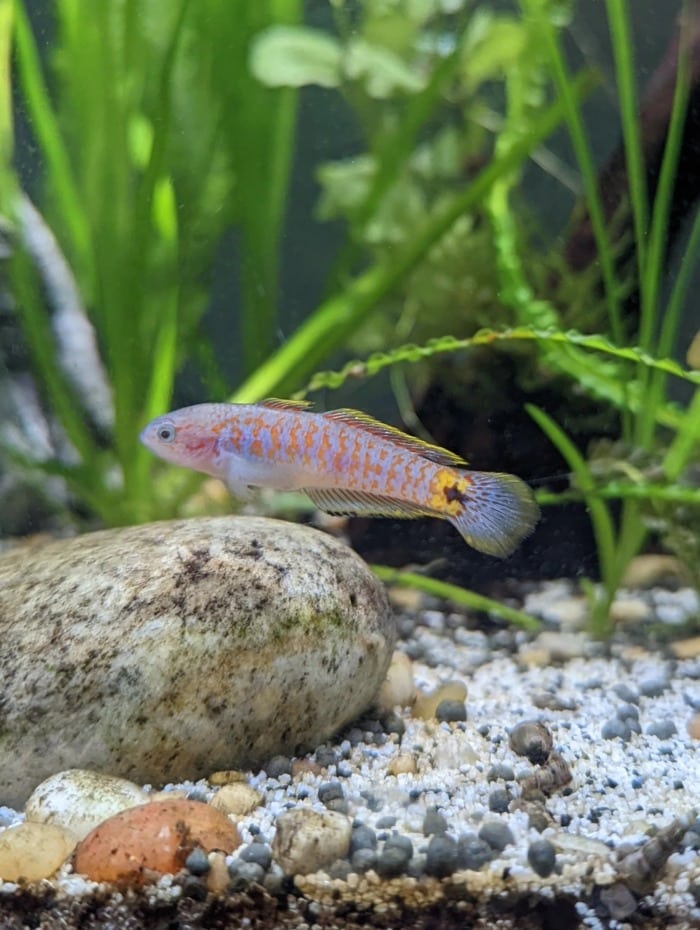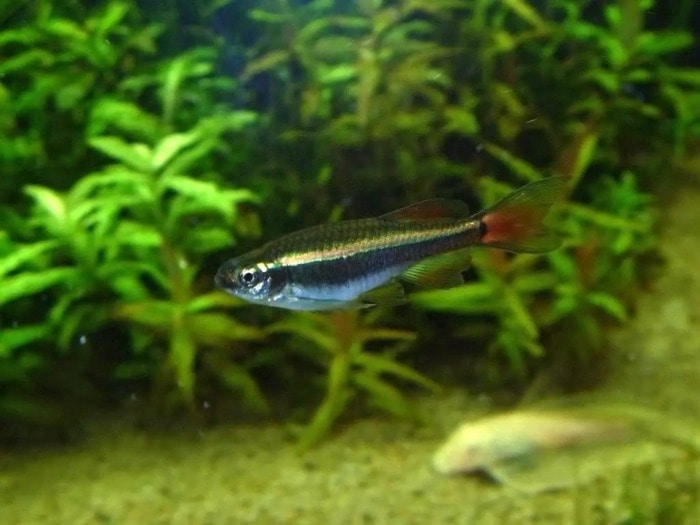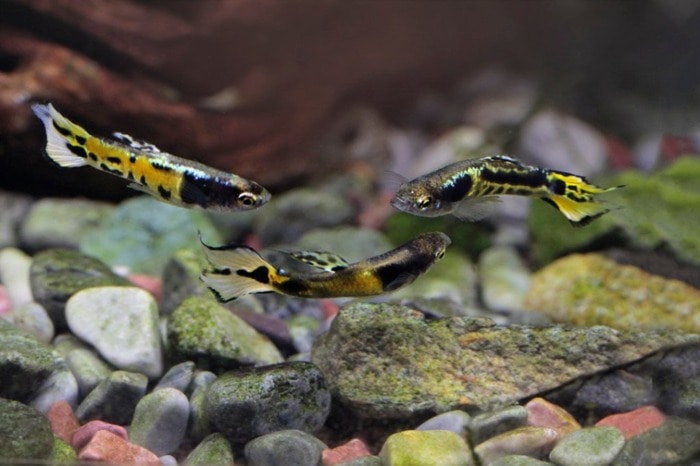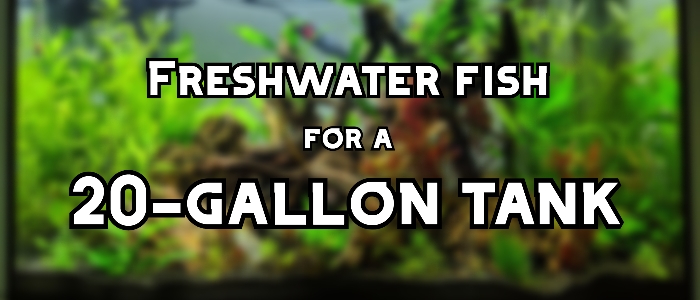The popular saying, “size doesn’t matter” may sound appealing to some, but it certainly doesn’t hold any truth when it comes to aquarium sizes.

The species and number of freshwater fish that you can keep as a community in your new 20-gallon tank are limited.
Regardless, there are still plenty of stocking ideas for those of us with a 20-gallon aquarium. Small fish species like rasboras and tetras are usually the most popular choices, but there are some bigger ones that are also an option.
Even though I’m not a huge fan of the latter, I decided to include them in this list as some of you might find them to be good centerpiece specimens.
With that being said, it’s time to plunge in and see the best species of freshwater fish for a 20-gallon tank.
The 12 Best Freshwater Fish for a Bustling 20-Gallon Tank
A 20-gallon tank is probably the best option for novice fish keepers and intermediate hobbyists, as you can place it almost anywhere in your home or office. At the same time, you can build a beautiful aquarium with a good variety of fish and decorative elements.
In this post, I’m going to list some of the best fish species you can have in a tank of these dimensions.
In case you’re a total beginner, check out this post first to learn more about what you’ll need for a freshwater fish tank.
Anyways, here are the finest freshwater fish for a 20-gallon aquarium:
1. Peacock Gudgeon â Tateurndina ocellicauda

by Twitchy993
| Maximum size: | 2.5 – 3 inches (6.3 – 8.9 cm) |
| Temperament: | Peaceful |
| Suitable for beginners: | Yes |
The Peacock Gudgeon is actually the only member of the genus Tateurndina and it’s native to Papua New Guinea.
This fish has a series of vertical lines of red and neon blue along its entire body, but what is most striking is the series of vibrant yellow lines that surround its fins. This gorgeous freshwater fish can reach a size of about 2.5 to 3 inches (6.3 cm) in the wild.
Peacock Gudgeons are quite peaceful fish and have no problems living with other animals of a similar size.
Sometimes you’ll see the males fighting each other, but that’s nothing to worry about since they love to live in groups.
In fact, I’ve seen that most of the time, Peacock Gudgeons prefer to hide among plants, rocks, and driftwood to avoid confrontations.
2. Zebra Danio – Danio rerio

by Fonske
| Maximum size: | 2.2 inches (5.6 cm) but on a rare occasions a specimen can reach 2.5 inches in length (6.3 cm) |
| Temperament: | Very peaceful |
| Suitable for beginners: | Yes |
The zebrafish from the Danio genus is among the more popular fish in the hobby.
These fish are usually 2.2 inches long, but some individuals can reach 2.5 inches.
You can easily recognize Zebra Danios thanks to the horizontal blue stripes that run along their entire torpedo-shaped body.
Zebra Danios are pretty peaceful which makes them a great fit for community tanks. However, they have a habit of harassing large-finned fish because they see them as a threat.
In my experience, since this is a schooling fish, it’s best to keep a group of at least 7 Danios, as they tend to form hierarchies and become less aggressive.
3. North American Rainbow Darter Fish – Etheostoma caeruleum

by Lepisosteus
| Maximum size: | 2 – 3.5 inches (5 – 8.9 cm) |
| Temperament: | Peaceful |
| Suitable for beginners: | a certain level of experience is required, especially when it comes to the food, as they are known for being picky eaters |
Rainbow Darters belong to the genus Etheostoma, a family of fish typical of North America, although there are also some in Mexico.
As adults, these fish can reach a maximum size of 3.5 inches (9 cm).
These fish stand out with their vibrant green and orange vertical stripes which is why they are often used as centerpiece species.
This color pattern is also prevalent in their large fins, giving Rainbow Darters a somewhat imposing look.
But even with this appearance, the Rainbow Darter is an extremely shy fish that prefers to hide among aquatic plants at any sign of danger.
Don’t even think about placing it in a tank with aggressive species, as it’ll most likely end up as their lunch.
4. Honey Gourami – Trichogaster chuna

by teatimebby
| Maximum size: | 3.2 inches (about 8 cm) |
| Temperament: | Peaceful |
| Suitable for beginners: | Yes |
As its name indicates, the Honey Gourami (Trichogaster genus) has a color midway between orange and honey (somewhat similar to the common Goldfish but less intense).
This color is typical of adult males, while females maintain a silvery gray color.
Honey Gouramis can reach a maximum size of 3.2 inches, and it’s easy to confuse them with other Trichogaster fish due to the similarity in their colors.
This fish is very peaceful and will spend most of its first days in your aquarium hidden among the plants. I recommend that you get a good supply of quality aquarium plants so that they feel happy.
The Honey Gourami is a hierarchical fish that works very well in small groups of about 5 individuals.
You’ll see some clashes between them, but nothing important.
Author’s note: Honey gouramis are omnivores that prey on small invertebrates and insects in the wild. They capture them by squirting water and knocking them down from vegetation.
5. Spotted Rainbowfish – Pseudomugil gertrudae

by mbuna55
| Maximum size: | 1.5 inches (around 3.8 cm) |
| Temperament: | Peaceful and quite timid |
| Suitable for beginners: | Yes, but it takes some knowledge to breed them successfully |
From the genus Glossolepis, the Spotted Rainbowfish is another fish native to Papua New Guinea.
Their body is usually colored silver with some shades of bronze while their fins are covered in black polka dots.
Spotted Rainbowfish are timid schooling fish, so you should be very careful when keeping them in a community tank. In these cases, other, more active species might easily outcompete them for food.
I’ve found that the best way to avoid this is to put it in a school with at least 7 specimens.
This helps the fish feel more secure in an environment with a variety of different species.
This Spotted Rainbowfish also loves lush vegetation, so it’ll feel right at home in a planted aquarium.
6. Common Guppy Fish – Poecilia reticulata

by Sgooosh
| Maximum size: | 1.4 inches (3.5 cm) for males, 2.4 inches (6 cm) for females |
| Temperament: | Peaceful and social |
| Suitable for beginners: | Yes |
The common Guppy belongs to the Poecilia genus.
These fish are native to Venezuela and are quite common in beginner aquariums, mainly due to their color variety and resilience.
Male guppies sport an extravagant fan-shaped tail and a vibrantly colored body, whereas
females appear plainer with their metallic gray body and nondescript tail. Although guppies may look somewhat delicate, with proper care they can live up to 5 years.
In general, these fish are peaceful and sociable, but they’re also very active and need ample space to feel happy.
7. White Cloud Mountain Minnow – Tanichthys albonubes

by netty_3164
| Maximum size: | 1.4 inches (3.6 cm) |
| Temperament: | Peaceful |
| Suitable for beginners: | Yes |
White Cloud Mountain Minnows are a species of small aquarium fish that belong to the Tanichthys genus. If you have a keen eye, you might notice the body shape of these tiny fish resembles a torpedo.
Unlike the lackluster color design of torpedoes, however, these fish possess an impressive array of colors.
In fact, most of their body has a dark green tone, with a long horizontal silver line that runs through their entire body and red and yellow tones on their fins.
However, some of the other variants that are found mostly in China show slight variations in color.
White Cloud Mountain Minnows are typically a peaceful and cooperative schooling species.
However, I’ve observed that during the mating season, their behavior becomes slightly aggressive and territorial.
8. Cory Catfish – Corydoras geoffroy

by mottyfindles1734
| Maximum size: | 2.8 inches (7 cm) |
| Temperament: | Peaceful |
| Suitable for beginners: | Yes |
Fish belonging to the Corydoras genus are commonly referred to as Cory Catfish.
These fish can reach a maximum size of 2.8 inches in their adulthood and usually live up to 5 years.
There are several species of Cory Catfish and most are quite similar in appearance.
They have protective bone armor that covers their entire body, and most come in similar color patterns.
These fish are often confused with small plecos because of their whiskers. Even though both are bottom-dwelling species, plecos belong to an entirely different genus.
You can distinguish Cory Catfish from plecos by the round shape of their body and muzzle.
These fish are extremely peaceful and social, so they won’t attack other species in the aquarium.
In fact, they’ll spend most of their time burrowing to the bottom of the tank looking for food, occasionally rising to the surface to get some oxygen from the air. Since this fish loves to burrow into the substrate, you may find the information in this article interesting.
9. Red Neon Stiphodon Goby – Stiphodon semoni

by odyssey
| Maximum size: | up to 2 inches (5cm) |
| Temperament: | Peaceful |
| Suitable for beginners: | Yes |
The Red Neon Goby from the Stiphodon genus is a colorful fish that’s usually found in Asian countries such as Japan and the Philippines.
Its relatively small size and tranquil nature make it ideal for a 20-gallon tank.
You can easily recognize males by their neon red and orange colors, in addition to the blue hue near their head.
Females, however, are less colorful but equally appealing nevertheless.
These fish tend to get along well with other species, but males do occasionally fight each other for territory.
Author’s Note: Even though these fish are relatively easy to care for, it is important that you keep a good amount of algae and biofilm in your aquarium, as this is key to their health.
10. German Blue Ram – Mikrogeophagus ramirezi

by dedlikemoi
| Maximum size: | 3 inches (7.6 cm) |
| Temperament: | Peaceful and social |
| Suitable for beginners: | Some experience is needed |
German Blue Rams (Mikrogeophagus genus) are members of the cichlid family and are typically found in the Orinoco River basin between Colombia and Venezuela.
Blue Rams grow up to 3 inches in their adulthood and generally have quite an exotic visual appearance.
Their body is coated in shades of blue, yellow, and red with black spots at certain parts of their body.
Their dorsal fin is especially interesting as it gives them a “punk style hairdo” sort of look. These dwarf cichlids are quite peaceful and social fish, and they’re usually very active near the middle and bottom of the tank.
This is one of my favorite fish, as they have a good memory and usually recognize me when I approach them, especially at feeding time.
However, I have to point out that these fish aren’t suitable for beginners, as they’re especially sensitive to fluctuations in the levels of ammonium and nitrate in the water.
11. Male Endlers â Poecilia wingei

by Fonske
| Maximum size: | 1 inch for the males, 1.8 inches for the females (2.54 cm for males and 4.6 cm for females) |
| Temperament: | Peaceful |
| Suitable for beginners: | Yes |
Male Endlers (Poecilia genus) tend to be much smaller and notably more colorful than females.
Their typical color pattern includes splotches of orange, green, and black.
Male Endlers are tropical fish mainly found in Venezuela and are one of the tiniest species on this list, with an adult size of only 1 inch. However, their lifespan is anything but short for such a minute species of fish.
With proper care, you can enjoy the company of these fish for the next three years.
If you’re going to include the Male Endlers in your community setup, you should carefully pick their tank mates as they can easily be gobbled up by larger predatory fish.
I recommend placing them with other small species of peaceful fish that won’t attack them.
Unlike other similar fish species, the females in this case are territorial.
So in this case, the best decision is always to opt for the males if you want a less aggressive school.
12. Neon Tetra – Paracheirodon innesi

by thestrangeguy0008
| Maximum size: | Up to 1.4 inches or 3.5 cm |
| Temperament: | Peaceful |
| Suitable for beginners: | Yes |
Neon Tetras from the Paracheirodon genus are among the most popular fish in the hobby.
They can be instantly recognized by the horizontal blue line that runs through the length of their body.
These fish are quite social and can become the life of the party if they’re with the right crowd.
To bring out the best in them you should keep Neon tetras in the company of rasboras, danios, and dwarf gouramis.
Neon Tetras like to spend most of their time swimming in the middle of the tank, moving from one end to the other in small schools.
You can imagine that with proper lighting and some good tank buddies, the party is guaranteed.
Which of these fish can live together in a community tank?

by Maniscalco Aquascape
The compatibility of fish in a community tank depends on several different factors such as size, social behavior, and maintenance conditions.
Due to this, some of the fish on this list might not be compatible with each other.
To spare you the mental gymnastics, I’ve listed some stocking ideas that will help you create your combos more easily:
- Zebrafish – Combine well with Danios, Tetras, and Corydoras.
- Guppies – Adaptable and resilient, will get along with pretty much every species on the list.
- Neon Tetras – Combine well with Danios and Guppies.
- Honey Gouramis – Get along with Cory Catfish, Zebra Danios, and Guppies.
- Corydora Catfish – They can coexist with a variety of other species such as Neon Tetras, Guppies, and Honey Gouramis.
You can find any of the freshwater fish listed above in most online fish stores. Here are a couple of options to check out for yourself:
How Many Freshwater Fish Can You Keep in a 20-Gallon Aquarium?

When it comes to the number of fish you can keep in a 20-gallon aquarium there aren’t any reliable guidelines you can follow.
Some fish keepers may recommend you use the “one inch of fish per gallon of water” rule to figure this out, but I would advise against it.
If we follow this rule, then it should be perfectly fine to keep a twelve-inch Jack Dempsey along with a couple of Male Endlers in a 20-gallon tank, right?
Wrong.
The Jack Dempsey Cichlid will not only feel imprisoned in a tank of such size but will also try to cope with the stress as we people do, by eating.
And, no, it’s not the fish food it’s going to eat first.
To estimate the right number of fish for your 20-gallon tank, I recommend you thoroughly research the specific requirements and most importantly, the bioload of each fish. This will reduce the risk of the ammonia and nitrate spikes that often result from overstocking an aquarium.
What’s The Biggest Freshwater Fish You Can Put in a 20-Gallon Tank?
Although there are other somewhat bigger fish on this list, the German Blue Ram is the best option if you want a centerpiece fish to draw people’s attention to your 20-gallon aquarium.
This fish is quite colorful, sociable, and active, as well as being the appropriate size in relation to the size of the tank.
However, remember that it needs special care that requires you to have some experience.
Some people will say that the Common Angelfish is a better option, but this fish can be up to 6 inches (15 cm) in diameter, so it’s best if you keep them in larger tanks.
The other option is the Honey Gourami, although it is less flashy than the German Blue Ram.
Suggested to read next: Best Fish for a 10-Gallon Aquarium


